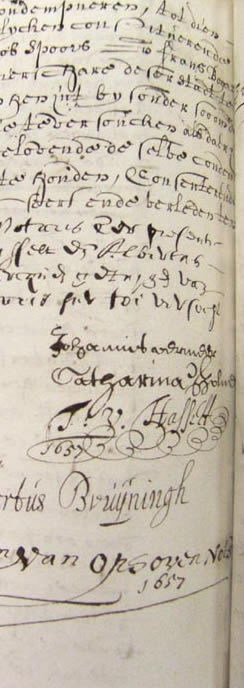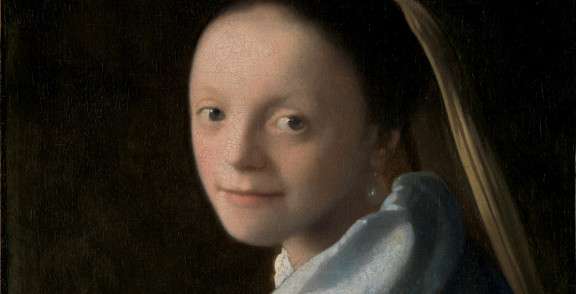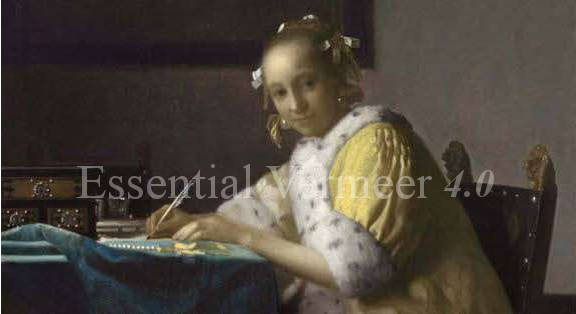Pieter van Ruijven
According to John Michael Montias, the only collector of Vermeer's paintings who can justly be called a patron was Pieter van Ruijven. The principal fact which links Van Ruijven to Vermeer's assumed patronage are the twenty-one Vermeer paintings which were part of the 1696 auction of Jacob Dissius estate. Dissius married Van Ruijven's daughter Magdalena and Montias believes that in all probability the couple inherited most of the paintings purchased directly from Vermeer by Magdalena's father. Furthermore, Montias believes that the relationship between Vermeer and Van Ruijven went far beyond that of artist and client. Montias' various arguments are exposed in detail in the chapter entitled "Vermeer's Clients and Patrons" in his fascinating Vermeer and His Milieu: A Web of Social History.1
"Direct evidence that Van Ruijven and his wife were serious collectors of paintings is provided by their joint will made on 19 October, 1665, which stipulated that their collection of paintings should be disposed of as specified in a certain book marked with the letter A, on which would be written "Dispositions of my fine paintings [Schilder-konst) and other matters." Unfortunately, that book has been lost.

30 November, 1657. [200 guilders on loan by Pieter Clasz. van Ruijven]
Op huijden den lesten November anno XVIC sevenvyfftich, Compareerden voor my Joan van Ophoven openbaer Notaris... mitsgaders voorden naegenoemde getuygen Johannis Reyniersz. Vermeer schilder, ende Catharina Reyniers Bolnes syne huysvrou ....
[signed:]
Johannis Vermeer
Catharina Bolnes
(T. v. Hallitt ? 1657)
Albertus Bruijningh [clerks as witnesses]
Joan van Ophoven, Notaris, 1657
(akten van notaris J. van Ophoven no. 1952, fol. 99 en 100)
Though it now seems most probable that van Ruijven bought the greater part of Vermeer's production after 1657, including many of the surviving works, nothing is recorded of the extent to which this relationship affected the character of Vermeer's art. But there are two or three more pieces of evidence from the archives that provoke speculation. Pieter van Ruijven was related to some of Delft's most prominent families, says Montias, but because the family had Arminian sympathies he, like his father before him, was barred from high civic office. His father had been a brewer but Pieter Claesz. van Ruijven is not known to have had any trade or profession. He and his wife inherited wealth which they augmented by judicious investments. And on 11 April, 1669, van Ruijven bought for 16,000 guilders land that carried with it the title Lord of Spalant, a title that he used when he witnessed the will of Vermeer's sister only a few months later. Finally, it may be significant that when Van Ruijven, who was eight years Vermeer's senior, died and was buried on 7 August, 1664, the artist outlived his patron by only seventeen months. All this suggests, but is far from proving, a friendship between artist and patron that may have influenced Vermeer's art. A further reason for considering the hypothesis sympathetically is that it complements the other probability of Vermeer's career, that he lived a quiet, even isolated, life, dependent on the wealth of his mother-in-law. A friend such as van Ruijven could have been a friend indeed."2
While Arthur K. Wheelock Jr. recognizes Van Ruijven's importance, he believes that available evidence does not definitively prove that Van Ruijven purchased even a single painting from the artist. Wheelock states: "While Van Ruijven may have acquired paintings from Vermeer, it seems unlikely that he assumed as important a role in the artist's life that Montias believed." Ben Broos3 as well casts serious doubt upon Montias 'theory by which Van Ruijven "was just about Vermeer's sole buyer." Both Broos' and Wheelock's arguments can be read in the Vermeer exhibition catalogue of 1994–1995. Montias' essay." The recent "Archival Research on Vermeer" provides an articulated rebuttal with the support of some newly discovered documents and reconsideration of existing ones.4
Please note that there exists absolutely no historical evidence that would suggest that Pieter van Ruijven was a predatory lecher as he was portrayed in the fictional movie Girl with a Pearl Earring, based on Tracy Chevalier's novel of the same name.
† FOOTNOTES †
- John Michael Montias, Vermeer and His Milieu: A Web of Social History, Princeton, NJ: Princeton University Press, 1989
- John Nash, Vermeer, New York and London: Scala Books, 2002, 22–23
- Arthur K. Wheelock Jr., exh. cat. Johannes Vermeer, eds. Arthur K. Wheelock Jr. and Ben Broos, London and New Haven: Yale University Press, 1995
- John Michael Montias, "Recent Archival Research on Vermeer," in Vermeer Studies, .eds. Ivan Gaskell and Michiel Jonker, National Gallery of Art Washington D.C., New Haven and London: Yale University Press, 1998.




 or anything else that isn't working as it should be, I'd love to hear it! Please write me at:
or anything else that isn't working as it should be, I'd love to hear it! Please write me at: